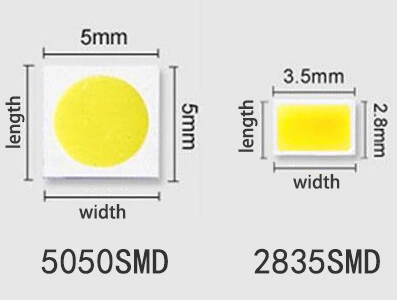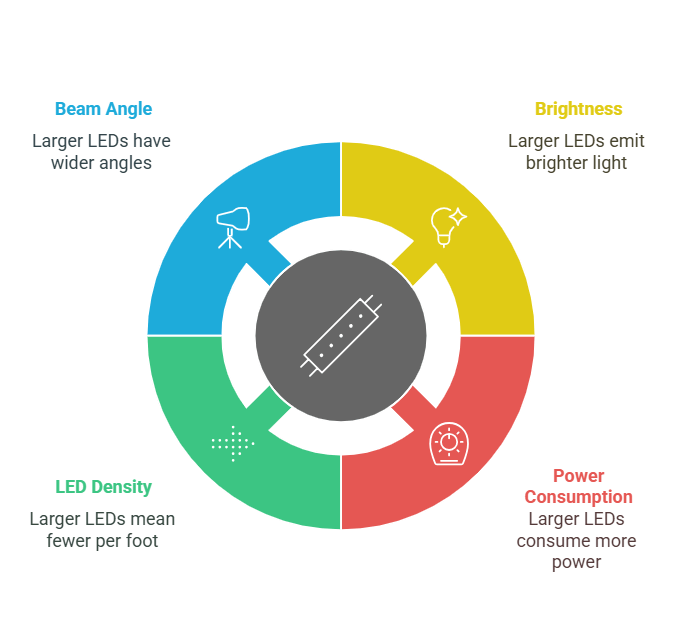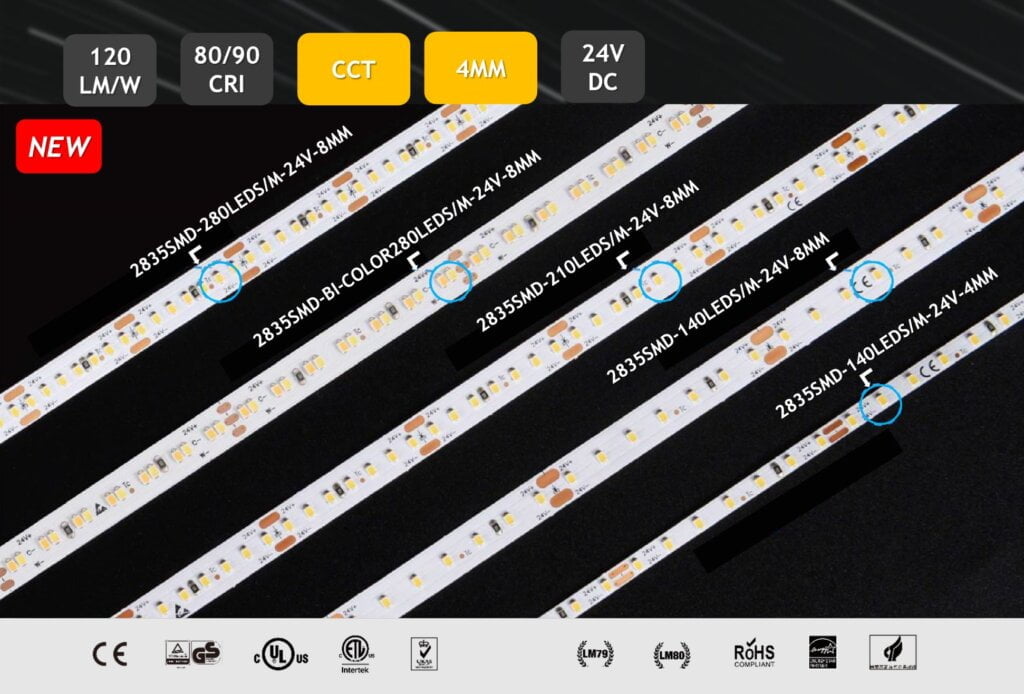LED Numeric Codes: The Meaning Behind 2835, 3528, and 5050
Table of Contents
When looking to buy LED strips, you may encounter various numerical specifications such as 2835, 3528, and 5050 that might warrant some explanation. These figures essentially represent the size dimensions of the LED chips. But what exactly do these numbers mean, and why are they relevant?
The four numbers you’ll come across when dealing with LEDs, like 2835, 3528, and 5050, is a coded way to convey the LED’s size. Of the numerous sizes available in the market, these three are the most prevalent. A number such as 2835 refers to an LED chip that measures 2.8mm by 3.5mm, whereas 3528 and 5050 correspond to chips that measure 3.5mm by 2.8mm and 5.0mm by 5.0mm, respectively. However, these figures not only reflect the sizes but also denote the unique characteristics of the LED chips.
This article will delve into the specifics of LED numbers, their interpretations, properties, and how they differ.

What Are LED Numbers?
LED numbers signify the size of the LED in millimeters. In a four-digit code, the first two digits denote the width of the LED, and the last two describe its length. These codes typically come prefixed with ‘SMD,’ an abbreviation for ‘Surface Mounted Device.
For instance, SMD2835 implies that the LED’s width and length are 2.8 millimeters and 3.5 millimeters, respectively. Hence, a larger number signifies a larger LED size. Among the many different LED sizes, the most commonly encountered are 2835, 3528, and 5050.
Why Are LED Numbers Significant?

The size of the LED chips largely determines the lighting effect of an LED fixture, such as LED strips. Larger chips yield brighter illumination than their smaller counterparts, making LED numbers vital information as they denote the LED chip sizes.
With the help of these LED numbers, you can easily ascertain the lighting output of the fixture. For instance, an SMD5050 LED strip possesses larger LEDs than an SMD2835 strip, meaning that the SMD505050 strip will emit brighter light. Consequently, these numbers provide insight into the brightness of the LED. They also inform you of the number of LEDs that can be accommodated per foot of PCB, with larger LEDs implying fewer chips can fit.
Furthermore, these numbers reflect the LED’s power consumption, light intensity, beam angle, and efficiency. These figures, however, may differ based on the LED’s density and the manufacturer. Different brands have set standardized values for specific SMD numbers. For example, a 5050SMD 120LEDs single color LED strip from MyLikeLed has a power of 28.8 W and a beam angle of 120 degrees. Therefore, LED numbers are crucial for understanding the chip size, brightness, and power consumption, providing a holistic lighting view.
What does SMD mean in LED?
Before delving into the term ‘SMD,’ let’s first understand the structure of LED strips. The LEDs are inserted into a thin printed circuit board (PCB) sans any wiring in an LED strip. These directly-mounted chips are referred to as Surface Mounted Devices or SMDs. Therefore, ‘SMD’ is often erroneously used interchangeably with ‘LEDs,’ but not all LEDs are SMDs – some are COB or MCOB.
The acronym SMD is used alongside the four-digit numbers to indicate the size of the LED chips. Therefore, terms like SMD2835, SMD3528, and SMD5050 denote varying LED sizes. However, we will explore each number with specific attributes in this article.
What does SMD2835 signify?
SMD2835 denotes an LED with a 2.8 mm width and a 3.5 mm length. It bears a strong resemblance to the SMD 3285 chips in terms of appearance. The recent advancements in 2835 have significantly enhanced its reliability and steadiness. SMD 2835 LEDs are brighter and more energy-efficient than their SMD 3285 counterparts. Owing to their dimensions, they are frequently used in LED strips. Moreover, these are high-output LEDs with a prolonged lifespan.
What does SMD3528 represent?
SMD 3528 refers to Surface Mounted Devices that are notably smaller, measuring 3.5 mm in width and 2.8 mm in length. Each of these LEDs houses a single diode. Because of their reduced dimensions, more chips can be incorporated per foot of the Printed Circuit Board (PCB). Typically, they are used in LED strips with 60 LEDs per meter. Nevertheless, MyLikeLed SM3528 LED strips are available in configurations of 60LEDs, 120LEDs, 180LEDs, and 240LEDs per meter. Plus, customization options are available!
What does SMD5050 entail?
The SMD5050, measuring 5.0 mm x 5.0 mm, is as renowned as the SMD 3528. It is a tri-chip LED, incorporating three diodes in a single LED, emitting three times the light of a one-diode SMD3528 chip. This makes it ideal for “task lighting” in workspaces like kitchens and study rooms.
SMD 5050 chips are apt for RGB lighting, allowing the creation of millions of color shades due to their three-in-one design. Furthermore, they are a perfect fit for general lighting in various settings like homes, bars, restaurants, hotels, and other establishments, replacing bright fluorescent lighting.
What distinguishes 2835, 3528, and 5050 LED strips?
Apart from chip dimensions, there are several distinguishing aspects between 2835, 3528, and 5050 LED numbers. You can refer to the table below for more details-
| Factors | SMD2835 | SMD3528 | SMD5050 |
| LED Size | 2.8mm * 3.5mm | 3.5mm * 2.8mm | 5.0mm * 5.0mm |
| LED Size Type of Chip |
single-chip | single-chip | tri-chip |
| Brightness | High | Medium | Highest |
| Light emitting surface | Rectangular | Circular | Circular |
| Heat dispersion rate | Less | More | More |
| Price | Medium | Cheap | Pricey |
In summary, while SMD2835, the smallest chip, offers superior heat dissipation, SMD5050 is the go-to choice for the brightest output. However, when affordability is the key factor, SMD3528 is the most economical option.
Comparing SMD2835 and SMD3528: Which Outperforms the Other?
SMD2835 and SMD3528 are prevalent types of LED chips, each with distinct features. To determine which is superior, it’s essential to understand their differences:
| Criteria | SMD2835 | SMD3528 |
| LED Size | 2.8mm * 3.5mm | 3.5mm * 2.8mm |
| Technology | Latest | Old |
| Brightness | Higher | Lower |
| Light emitting surface | Rectangular with round edges | Circular |
| Heat dispersion | Better | Regular |
| Price | Expensive than SMD3528 | Affordable |
An initial glance at the comparative chart above would suggest that SMD2835 has an edge over SMD3528. Here’s a detailed explanation as to why:
- SMD2835 incorporates the most recent technology, unlike SMD3528, a pioneering LED chip. The innovation in SMD2835 addresses the point light source issue typically seen in 3528 lighting applications.
- The luminous surface of SMD2835 is rectangular with rounded corners, whereas the SMD3528 chip has a circular light-emitting surface. Upon comparing their surface areas, SMD2835 possesses 2.1 times more luminous area than SMD3528, leading to brighter, more consistent lighting.
- SMD2835 stands out for its exceptional heat dispersion. It’s slim design and broader cooling surface allow it to generate considerably less heat than SMD3528.
- SMD2835 is more efficient as it provides the same brightness level while utilizing less energy than SMD3528.
In light of these considerations, it’s evident that SMD2835 is superior to SMD3528.
SMD3528 Vs. SMD5050: Which Takes the Lead?
At a glance, SMD3528 and SMD5050 appear quite similar as they both possess circular light-emitting surfaces and are nearly identical in physical appearance, barring their sizes. However, they differ when it comes to their lighting capabilities. Let’s delve into these differences before settling on the better option.”
| Criteria | SMD3528 | SMD5050 |
| LED Size | 3.5mm * 2.8mm | 5.0mm * 5.0mm |
| Chip Type | Single-chip | Tri-chip |
| Brightness | Lower | Higher |
| Color option | Single color | Versatile color |
| RGB Application | No | Yes |
| No. of chip/foot | More than SMD5050 | Limited due to large chip size |
| Price | Cost-effective | Expensive |
Understanding this chart might seem tricky as both SMD variants possess distinct advantages. However, a size-based comparison between the SM5050 and SMD 3528 should aid you in identifying the perfect option for your needs:
- SMD3528 is 3.5mm * 2.8mm, whereas SMD5050 measures 5.0mm * 5.0mm. Hence, the light-emission area of the SMD5050 surpasses that of the SMD3528.
- Regarding luminosity, the SMD5050 emits light threefold brighter than the SMD3528, making it an ideal choice for ambient and task lighting.
- The SMD3528 is equipped with a single diode chip. In contrast, the SMD5050 is a triple diode chip, accommodating three separate diodes within a single chip. This capability results in exceptional brightness and provides possibilities for multi-color lighting.
- RGB lighting is assembled using SMD5050 chips, as it comfortably accommodates the red, green, and blue diode within its triple diode chip. As a result, you can generate millions of color variations with the SMD5050 chip. However, the SMD3528 is designed for single-color lighting, while the SMD5050 is versatile enough to facilitate monochrome and RGB lighting.
In summary, the SMD5050 provides superior brightness and diverse lighting options. Yet, due to its larger chip size, only a limited number of SMD5050 chips can be fitted per foot on a PCB, limiting its overall brightness. In contrast, more SMD3528 chips can be mounted per foot on a PCB due to their smaller size and more cost-effectiveness. Therefore, if you desire high-intensity, single-color lighting, SMD3528 would be preferable.

Exploring Different Numbers Utilized in LED Strip Lights
While the more familiar LED numbers like 2835,3528, and 5050 are widely recognized, an array of other chip sizes are incorporated into LED strip lights. Here are some examples:
- SMD1808: As one of the smallest LEDs, the SMD 1808 measures a mere 1.8*0.8mm.
- SMD2010 is a suitable substitute for the SMD1808, boasting dimensions of just 2.0*1.0mm.
- SMD3014: This LED, which measures 3.0mm * 1.4mm, is available in two types from MylikeLed: front-emitting and side-emitting.
- SMD2216: The dimensions of these LEDs are 2.2mm * 1.6 mm. Due to their smaller lamp size, SMD2216 LED strips can be more compact, resulting in a higher LED density.
- SMD2110: With a 2.1mm * 1.0mm size, the SMD2110 is a more durable version of the SMD2216, thanks to its thicker bead holder.
- SMD5630: These are the most luminous LED strips, measuring 5.6mm * 3.0mm in size.
Do Larger LED Chips Consume More Power?
While the chip size can influence power consumption, the assumption that larger LED chips draw more electricity only holds to an extent. It also heavily depends on the technology, not just the chip sizes. To illustrate, let’s use MyLikeLed 60 LEDs LED strips of various SMDs as an example:
| LED numbers | Current (A/m) | Power(W/m) |
| SMD5050 | 1.2A(12V) / 0.6A(24V) | 14.4W |
| SMD3528 | 0.4A(12V) / 0.2A(24V) | 4.8W |
| SMD2835 | 1A/0.5A | 12W |
As expected, SMD5050 consumes more power due to its larger chip size. But if we compare SMD2835 and SMD3528, where SMD2835 is smaller, it should theoretically use less electricity. However, it produces more light. Thus it consumes more power than SMD3528.
Is High Density or Large LED Chips Preferable?
So far, we’ve predominantly focused on size. However, you may be questioning whether density is a significant factor. In this context, “density” refers to the quantity of LED chips per meter on the strip.
Density = Number of Chips * Meter
Large LED chips yield a brighter light, but their size limits the number of SMDs per LED strip meter. So why would denser LED chips be advantageous?
A denser LED chip array will offer brighter, more even lighting. For instance, a one-meter strip can accommodate roughly 120 small SMD2835 LED chips, producing up to 2,600 lumens per meter. This results in greater brightness and uniformity than less dense arrangements. An SMD5050 one-meter strip can accommodate between 30 to 60 LEDs.
However, this doesn’t imply that high-density LED strips are always the better choice for achieving uniform lighting. Larger chips can also provide uniformity; cove lighting is an excellent example.
Closing Remarks
The last conversation has enlightened you on the various LED dimensions. In essence, the sizes of LEDs utilized in LED strips are what we term LED numbers. Among the array of numbers, 2835, 3528, and 5050, the smallest LED is represented by 2835, while 5050 signifies the largest LED. The significance of these numbers lies in their ability to denote different lighting impacts inherent to LED strips.
If you are searching for LED strips, look no further than MyLikeLed. We provide various sizes, densities, and energy efficiency levels of LED strips. Moreover, we also afford you the flexibility of customization.
FAQs
Generally, 5050 LEDs are brighter because they are larger and can contain three light-emitting diodes in one chip, while 2835 and 3528 usually have one diode per chip.
The 2835 chip is newer and more efficient than 3528, offering better brightness and heat dissipation even though both are similar in size.
Yes, 5050 LED chips are ideal for RGB lighting because they can house red, green, and blue diodes in a single chip, allowing for full-color mixing.
For most general lighting needs, 2835 LEDs are a good choice due to their brightness, efficiency, and compact size.
No, it’s not recommended to mix different chip types on the same strip as they have different power and brightness requirements.
Yes, larger chips like 5050 consume more power but also offer higher brightness, while smaller chips like 3528 are more energy-efficient but less bright.

Hi, I’m Xylia Xiong, a sales professional with 14 years of experience in the LED strip light industry. I specialize in providing tailored solutions, leveraging my expertise in LED products and the latest industry trends. Known for effective communication and problem-solving, I’m dedicated to helping lighting manufacturers, importers, and distributors achieve their goals.
Let’s work together to create customized solutions that exceed expectations.
Related Posts

The Best LED Strip Lights You Can Buy Right Now

Comparing WS2811 Vs WS2812B: Key Differences


